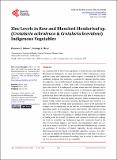| dc.contributor.author | Florence O Habwe, Walingo K Mary | |
| dc.date.accessioned | 2020-08-12T06:58:59Z | |
| dc.date.available | 2020-08-12T06:58:59Z | |
| dc.date.issued | 2019 | |
| dc.identifier.issn | Online: 2157-9458 | |
| dc.identifier.issn | Print: 2157-944X | |
| dc.identifier.uri | https://repository.maseno.ac.ke/handle/123456789/1991 | |
| dc.description | The article can also be accessed via URL;https://www.scirp.org/journal | en_US |
| dc.description.abstract | An estimated 20% of the world’s population is at risk for zinc (Zn) deficiency.
Micronutrient deficiencies are most prevalent in Africa and remain a major
problem facing poor populations, whose impact is worsened by HIV/AIDS
pandemic. Adequate zinc nutrition is essential for adequate growth, immunocompetence and neurobehavioral development. In Sub-Saharan Africa, Zn
deficiency risk stands at 34.6% with 25.6% of its population having inadequate zinc intake. It is widespread in areas where diets lack diversity and it
has been implicated as a contributing factor to stunting in approximately a
third of children in low-income countries. In Kenya, it is a public health
problem that about 50% of children under 6 years and 50% of women are affected. Zn deficiency rates are severe and pose severe consequences whose
impact would translate into poor economic development and would set a vicious cycle effect that will take many generations to correct if left unchecked. It
is important to examine zinc in the diet but its concentration in food varies
depending partly on processing besides other factors. The objective of this
study was to assess blanching as a food preparation method’s implication to
Zn levels in vegetables. Blanching is a method where vegetables are dipped
in boiling water for around two minutes and removed to avoid over cooking.
Zn levels in slenderleaf sp. Indigenous vegetable commonly found in the
Lake Victoria Basin region is not known. An experimental study was carried out to analyze zinc levels in raw and blanched slenderleaf sp. (Crotalaria ochroleuca & Crotalaria brevidens) vegetables. Results indicated that
blanching reduces Zinc levels in slenderleaf vegetables, however, the reductions are not significant; the levels after blanching are still vital. It is, therefore, recommended to minimize blanching time in order to reduce loss of
the vital nutrient in slenderleaf sp. vegetables. | en_US |
| dc.publisher | Scientific Research Publishing Inc. | en_US |
| dc.subject | Zinc Levels, Indigenous Vegetables, Slenderleaf, Crotalaria ochroleuca, Crotalaria brevidens, Blanching | en_US |
| dc.title | Zinc Levels in Raw and Blanched Slenderleaf sp.(Crotalaria ochroleuca & Crotalaria brevidens) Indigenous Vegetables | en_US |
| dc.type | Article | en_US |

